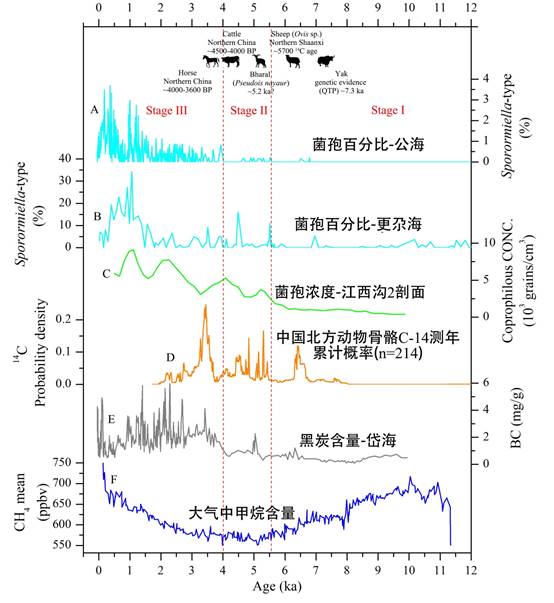Animal husbandry has been the main livelihood of people in the northern grasslands and the Qinghai-Tibet Plateau for a long time. However, there are relatively few archeological data and documentary records related to grazing activities, and there are great differences in the research results of animal archaeology, paleo-ecological records, and animal gene traceability. The start time, enhancement time and driving mechanism of the animal husbandry activities are still not clear. The agro-pastoral ecotone in northern China is sensitive to climate change, fragile ecological environment and has a long history of grazing activities. Therefore, it is of great significance to study the history and driving mechanism of animal husbandry development in northern China to understand the past changes of vegetation environment, the interaction between human and environment, and the process of geophysical changes caused by human activities.
Professor Huang Xiaozhong et al. extracted the records of Sporomiella-type faecal spore from the lake samples in Gonghai, Shanxi, compared the changes of faecal spore in the Genggarhai borehole and the Qinghai Lake Basin profile in the northeastern part of the Qinghai-Tibet Plateau, and compared the C-14 dating accumulation probability of animal bones (excluding pig bones) in archaeological sites in the northern part of China. It is suggested that the grazing activity in northern China began to appear at ~5.7-5.5 ka, and further intensified after ~4.2-4.0 ka. Based on the regional paleoclimate records, it is suggested that the development of animal husbandry activities in northern China may be related to climate change. During 5.7-5.5ka, the climate in some inland regions was dry, while the warm and wet monsoon climate in northern China caused some early herdsmen and their livestock to move eastward and southward to northern China. However, the cold and dry "4.2 ka event" led to population migration and promoted the expansion of herdsmen and animal husbandry methods in the northern grassland region. The rapid development and spread of animal husbandry in northern China after 3.6 ka was due to the use of domestic horses as grazing tools. Since large amounts of methane were produced in the digestive tracts of herbivores, compared with global changes in methane concentrations, enhanced grazing activities in the late Holocene may have contributed to the increase in atmospheric methane concentrations.
The findings were published earlier this April in Geophysical Research Letters,entitled "Intensification and Driving Forces of Pastoralism in Northern China 5.7 ka Ago".The present study provides a continuous, high-resolution, and independent record of changes in the intensity of grazing activity, which predates the traditional archeological view by about 1,500 years and needs to be confirmed by further research. This research will further promote the study of the impact of early human activities on the earth system, and help to promote the interdisciplinary development of paleoclimatology and archaeology.

This research was mainly supported by the major project of Natural Science Foundation "Historical Background of the Anthropocene" (Project No.: 41991251), the joint project of the Leading Special Project A of the Chinese Academy of Sciences "Ecological Environmental Impactions and Regulation Measures of the Human-Environment Interaction on Plateau" (Project No.: XDA2009000003), and the Second Scientific Expedition and Research Program of Qinghai-Tibet Plateau (No. 2019QZKK0601).Prof. Huang Xiaozhong is the first author and corresponding author of the paper. Ph.D. candidate Zhang Jun, College of Earth and Environmental Sciences; Ph.D. candidate Ren Lele, School of History and Culture, Lanzhou University, Associate Professor Zhang Shengrui, Hebei Normal University, and Academician Chen Fahu, Institute of Tibetan Higher Education, Chinese Academy of Sciences are co-authors.
The full-text links:
https://agupubs.onlinelibrary.wiley.com/doi/10.1029/2020GL092288